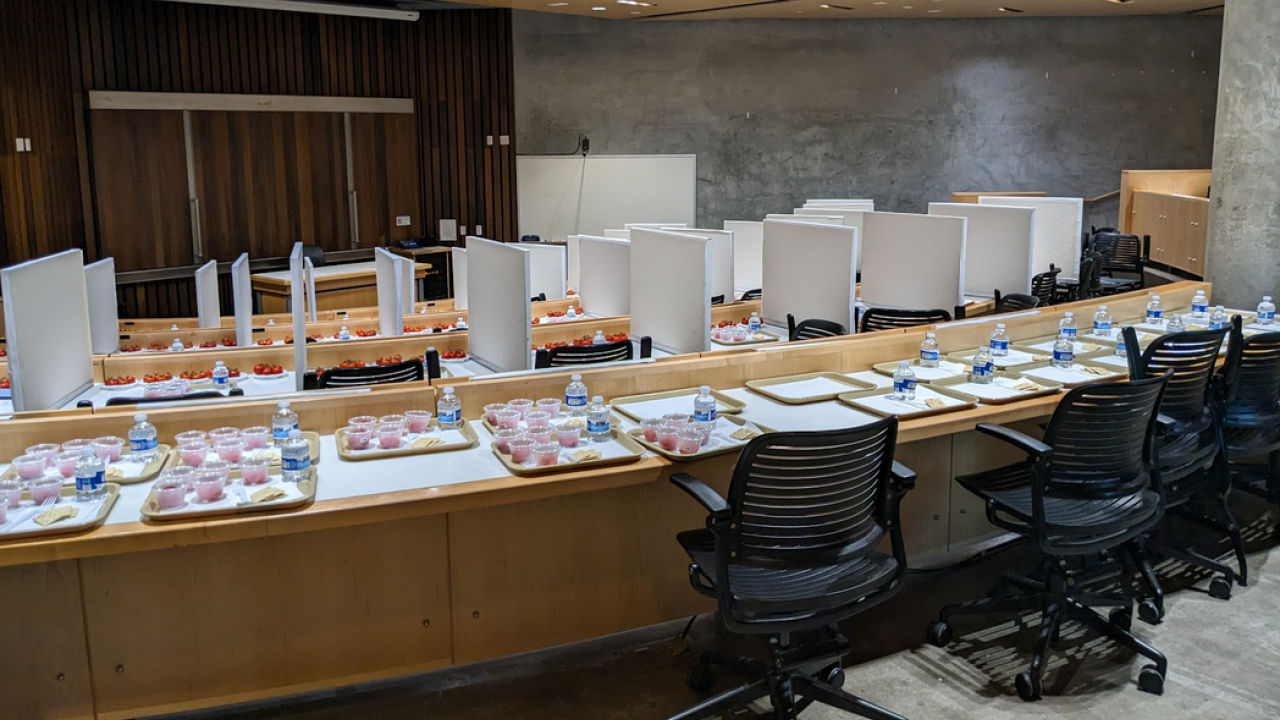
Sensory Tasting 101
What is Food Sensory Science?
Think of the smell of freshly baked cookies or the sound of biting into a crisp chip. These are all attributes that make food so memorable and enjoyable. Food sensory science measures the appearance, aroma, taste, mouthfeel and texture with either machinery or human opinion to understand why consumers gravitate towards specific foods. To learn more about preferences or if there is a significant difference between products, scientists have created tools and collected data to show how their product will be received in the market.
Whether a company is trying to switch out an ingredient or create the next snack craze, it goes through sensory testing. I sat down with Lik Xian Lim, a graduate student who works with sensory science every day, to learn more. “Sensory science is the piece that ties two ends together,” Lik explains, “What is in food, and why people like it.”
Selecting Panelists
Many sensory tests run through a “pre-screen” to see if the audience they are recruiting will fit the product being tested. For example, if there is a coffee consumer study, the pre-screen may ask how often coffee is consumed. This ensures that the final panelists fit into the target market, and are avid coffee customers.
Lik explains “It's hard to teach people how to drink coffee if someone is very sensitive to caffeine…that would drive a lot of the dislike towards that product. But if they like coffee, it’s better to train them so they can better distinguish products themselves.” Other screenings may be for allergens, demographics, age, and more.
Know Before You Go
Many sessions occur at the Robert Mondavi Sensory Theater. You may be part of a trained sensory panel, which you can read about here. Consumer sensory panels have a larger number of people, so people are more likely to be involved in these. Upon arriving at your specific time, the front desk will check you in and hand you a slip of paper with instructions for the test of the day. Go to your booth and be ready to take the test.
Once inside, you'll see rows of seats with dividers separating them. At each seat, there will also be a tray, napkins, crackers, bottled water, and the product. Use your device or the device provided to scan your QR code to start. If you have any questions during the test, raise your hand. The room itself may seem isolating at first, but the quiet atmosphere is purposeful to give everyone a chance to evaluate at their best, and to hinder influencing others based on comments made about the products.

Significance of the Tray and the Room
The water and crackers are provided to clear your palate between products. You'll also notice a white sheet underneath the products, which is helpful to understand the contrast between the product colors. Finally, if testing multiple products, you’ll notice 3-digit code printed on the container. These are to keep track of which product is which, without creating bias by the consumer. The numbers are completely randomized, so don’t get stuck on guessing any hidden meanings!
The RMI Sensory Theater is built specifically to keep air flowing through, so smells do not linger from past tests. There’s also a door on the left side that leads directly to the Food Innovation Lab. If a sensory test calls for hot food, this is an easy way to transport it from kitchen to tray.
Remember, everyone is different so there is no correct answer to evaluating products. It's simply getting to know what the consumer picks up about the product. Once the session is over, you may receive a thank you gift, such as a gift card. These items vary, so do not expect the item to be the same each time.
Your Impact
Sensory science is fascinating, but this research can’t be done without you! Your participation leads to a huge impact, from grapes and tomatoes, to changing worldwide fast food chains. Lik added a piece of advice for any panelist, “When you come, be comfortable so you can really taste and enjoy the product.” Afterall, you contributed to sensory research all while snacking on some free food. Who knew research could be so delicious?
More Exploration
The Guinard laboratory hosts many of the large group sensory testing, but there are many other faculty members on campus who use sensory science in their research as well.
The Delarue Laboratory uses digital technology to create an immersive environment when consuming food. This laboratory also explores unique methods of collecting data on food descriptions.
Dr. Charlotte Biltekoff researches the understanding of positive and negative connotations towards food, and how the consumer interacts with food socially and culturally.
Dr. Hildegarde Heymann from the Department of Viticulture and Enology continues sensory evaluation of grapes and wines with descriptive analysis methodology.
Professor Guinard has established various “flip” strategies, where a known factor of a food item is “flipped” for something healthier. His work is implemented in the dining commons at UC Davis today, with mushrooms incorporated into burger patties.
You can become a sensory testing panelist by filling out a recruitment form.

Gwen Gonzalez is a fourth-year food science major passionate about storytelling and food innovation. She is an active member of the Food Tech Club on campus and assists in Guinard's Lab pursuing sensory science. When she's not thinking about food, she immerses herself in music and the performing arts at the Manetti Shrem Museum and Mondavi Center for the Performing Arts. In the future, she hopes to merge her interests in food and the arts and contribute to creative research and development in the food industry.
